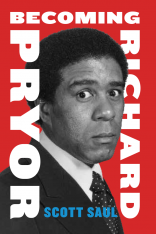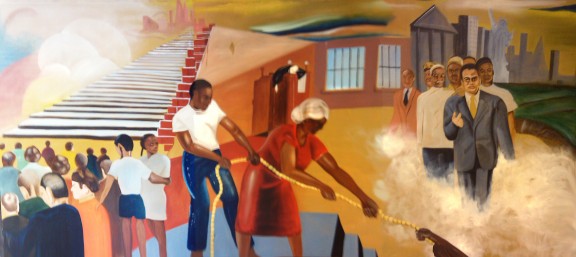Clarence Shivers’s Pursuit of Freedom (1949) suggests the complicated mix of energies behind the Carver Center: its belief in America and its challenge to America, its vision of working-class empowerment and its hopes for middle-class success. The teenage Richard would have faced the large mural whenever he performed in Carver’s auditorium.
The mural was painted as a triptych, and each of its three panels pulled the viewer in a different direction. On the right, a group of black leaders strode forward with dignity and assurance, the Statue of Liberty blessing their procession from behind. The figures were all male but offered a range of black achievement in the fields of science (George Washington Carver), law (Ralph Bunche), community service (Carver founder Ernest Attwell), sports (Jackie Robinson) and the military (Colonel Benjamin Davis, Shivers’s own commander in World War II).
If the right side of the mural offered a set of heroes worthy of emulation, the left side of the mural depicted the long journey to heroism. Two pig-tailed black girls joined a multiracial crowd poised at the bottom of a seemingly endless staircase heading to a beautiful city in the clouds.
In the center of the mural, Shivers underlined the difficulties behind the work of uplift. In the foreground, a working-class man in jeans and a white-haired black woman pulled on a rope that trailed down to a set of hands, which appeared to be holding on for dear life. The man in jeans bore a striking resemblance to Shivers himself, suggesting the depth of Shivers’s own commitment to the project of uplift.
Meanwhile in the background, Shivers added his most caustic element, one that none of Peoria’s newspapers noted in their coverage of the mural. A white judge — no Ralph Bunche — was slumped at his bench, as if he’d been murdered or was taking a very long nap. A vacant jail cell beckoned next to him. A wash of storm clouds hovered in the distance. There was a big gap, it seems, between the promise of the Statue of Liberty and the reality of justice in America.
In all, the composition of the mural suggested that young blacks would have to take a difficult, looping route to success. They would need to climb the first staircase in the lower-right, then the long second staircase in the upper-left. Only then could they leap over the sleeping judge and jail cell in the middle, and join the procession of heroes on the right. The pursuit of freedom was the work of a lifetime.

